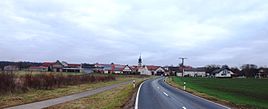Pusselsheim
|
Pusselsheim
Donnersdorf municipality
Coordinates: 49 ° 59 ′ 4 ″ N , 10 ° 22 ′ 59 ″ E
|
|
|---|---|
| Height : | 246 m |
| Residents : | 175 (1987) |
| Incorporation : | July 1, 1972 |
| Incorporated into: | Donnersdorf |
| Postal code : | 97499 |
| Area code : | 09528 |
Pusselsheim is a part of the municipality of Donnersdorf in the Lower Franconian district of Schweinfurt .
Geographical location
Pusselsheim is located in the extreme northwest of the Donnersdorfer municipality. The municipality of Grettstadt near Schweinfurt begins to the north , the district of Obereuerheim is closest to Pusselsheim. The district of Haßberge begins in the north-east , the federal motorway 70 runs through the municipality of Theres . To the east, also in the Haßberge district, is the Wonfurt district of Dampfach . To the southeast is Donnersdorf itself. To the west is Dürrfeld , part of Grettstadt.
history
The name of the place goes back to a founder personality and can be interpreted as "home of Busold". The village probably belonged to the settlements that arose during the Frankish colonization in the 6th and 7th centuries. The village was probably created together with the places Gädheim and Euerheim. During its history, Pusselsheim was part of the Würzburg monastery for a long time . At first it was subordinate to the Mainberg Office, before it came to the Gerolzhofen Office in 1692. Today it is part of the large community of Donnersdorf.
Culture and sights
Architectural monuments
The center of the village is the Catholic parish church. It is consecrated to the Würzburg bishop and saint Burkard and was built between 1775 and 1778 by the Würzburg master usurer. The west side is dominated by the tower with its constricted dome, which was incorporated into the Rococo facade. Several figures of saints characterize this side, for example figures of the Madonna, the church patron and St. Wendelin were placed here.
The oldest element of the furnishings is the font , which was created in 1597. The remaining elements came into the church when it was built at the end of the 18th century. The four-pillar high altar contains a picture of the Transfiguration of Burkardus and is flanked by two figures of Kilian and the same Burkard. The side altars were decorated with pictures of Wendelin and Our Lady. The pulpit and confessional are also Rococo.
In addition to the former rectory , a building from the early 19th century, many wayside shrines and small memorials have been preserved in Pusselsheim . Particularly noteworthy is the Mount of Olives group next to the church. It was donated by Anna Klühspies in 1862 and executed by M. Hauck. The village's oldest wayside shrine is a work from 1623 depicting the crucifixion. Typical Franconian pedestrian gates can also be found.
legend
There are many legends about the so-called Gründleinsloch . Once the daughter of the gentleman on the Zabelstein was sick and you no longer knew how to save her. A farmer who was knowledgeable about healing offered himself to get a certain medicinal herb . After a long search, the herb was found on the edge of the Gründleins spring and the daughter was saved. The farmer was thanked with a large land donation. He became the first settler at Gründleinsloch.
literature
- Karl Treutwein : From Abtswind to Zeilitzheim. History, sights, traditions . Volkach 4 1987.

